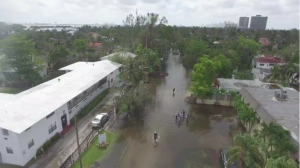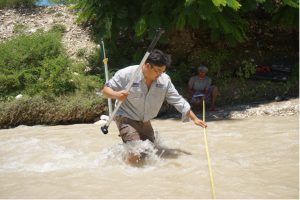There’s a current debate about whether our planet has entered a new geologic age called the Anthropocene, derived from two Greek words: “anthropo-“ for human being and “-cene” for new. It’s not an official geologic term quite yet, but it’s a way of thinking about when human beings became the dominant force on the planet – extinguishing its species, refashioning its surface, altering its atmosphere and average temperature, polluting its oceans with plastics and other debris, and other human activities that are altering the way the planet’s natural systems work – the very systems that support human life. “Anthropocene” calls our attention to human activity that is causing changes at all scales, from patterns of development that alter local weather and water flows to large-scale regional developments that draw down great rivers to trickles and create lakes so large that they can trigger seismic events and raising greenhouse gas levels in the atmosphere, resulting in global and regional effects on changing climate patterns, rising average temperatures, and rising seas.
How can we get our minds around patterns that are both large-scale and highly diverse? We must find a way if we are to respond to these changes and plan effectively for the future.
Dr. Young Gu Her’s Hydrology Work
Dr. Young Gu Her is an Assistant Professor in the Agricultural and Biological Engineering Department at the Tropical Research and Education Center in Homestead, Florida, who is working on these problems. Dr. Her uses computer models to reveal the interactions and effects of water as it moves through the landscape – a subject called hydrology. These interactions and effects are often critical to assure adequate freshwater for urban and agricultural use and for the health of wetlands and the natural environment, all of which are important in a state largely defined by its water resources.
Dr. Her’s location in Homestead, Florida, gives him the perfect “laboratory” to study these issues. On one side of Homestead lies the Miami metropolitan area, “one of the most populous urban agglomerations in the world,” stretching north from Homestead for over 100 miles along Florida’s “Gold Coast” through Miami, Ft. Lauderdale, Boca Raton, West Palm Beach, and dozens of smaller communities. It is home to over 6 million people. On the other side of Homestead is the Everglades, a vast subtropical wilderness and a hydrologic system that encompasses most of southeast Florida. The region is intensely urbanized and intensely agricultural. Underneath the region is the Floridan aquifer that delivers much of the area’s freshwater from regions further north. Lastly, the region is surrounded by ocean waters: the Atlantic Ocean on the east, Florida Bay on the south, and the Gulf of Mexico on the west. So not only must Dr. Her understand the interactions between water supply and water use, but he must understand the interaction between surface waters and ocean water as the intense use of freshwater allows saltwater to move further into coastal groundwater – this is called saltwater intrusion, and it changes the types of plant life that coastal areas can support. It’s an amazingly complex setting for a hydrologist.
Research and Insights
Dr. Her has studied South Florida hydrology and agriculture in a series of projects. In one of these, he examined the effect of increased salinity due to saltwater intrusion on two major products of South Florida’s ornamental plant industry, hibiscus and mandevilla, which represent significant dollar value to local growers. The levels of urbanization and agriculture in the area draw significant amounts of freshwater, which might influence saltwater intrusion. Dr. Her and colleagues investigated how the increasing levels of salinity would affect plant growth for hibiscus and mandevilla. They monitored the plants in the study using multispectral cameras, which can be used to detect plant stress caused by the salinity.

In another project, Dr. Her and colleagues examined the potential impact on the Everglades of climate change and the expected increase of severe weather events. Specifically, they examined the impact of runoff and nutrient loading on the western part of the Everglades. The Everglades are adjacent to many agricultural areas, which can complicate efforts to manage the health of these wetlands. Using several global circulation models to examine the impact of climate change on the Everglades region, Dr. Her and colleagues examined runoff and nutrient loads for time frames from 10 up to 60 years in the future using a watershed assessment model. The study demonstrated how “global-scale changes could differently affect the hydrology and water quality of the local natural and managed wetland watersheds” and provided help in developing “effective climate change adaptation plans to improve the sustainability of the Greater Everglades System.”
Investigating Water Quality and Sustainability
In the Biscayne Bay area, Dr. Her and his team are using a groundwater model to describe the interaction between the seawater and the freshwater in the Biscayne aquifer, adjacent to Biscayne Bay in southeast Florida. The Biscayne aquifer supplies water for over 4 million people in the area. Future sea level and climate projections were entered into the groundwater model to see how sea level rise and climate change individually and collectively affect the saltwater intrusion process and groundwater level. Dr. Her found that future sea level rise is likely to raise the groundwater level as much as projected sea level increases, with increasing potential for root zone flooding and even surface flooding in southeast Florida. Modeling also showed that saltwater intrusion may be accelerated by local water management practices such as pumping, but it is not very sensitive to sea level rise. This is surprising because many believe sea level rise may directly cause, or at least accelerate, saltwater intrusion. This can be true in areas like California where it takes much time for the groundwater aquifer to be recharged due to local soil characteristics. In southeast Florida, the soils are very permeable (limestone rocks) so that the Biscayne aquifer can be quickly recharged by a large amount of rainwater, which helps seawater and freshwater reach an equilibrium point quickly.

Dr. Her and his team are also working on the other great water body in the area, Lake Okeechobee. They are investigating how the lake’s internal hydrodynamic process and external water and nutrient loadings from the upstream Kissimmee River Basin affect the water quality of the lake, especially algal blooms. By using an integrated modeling framework that combines a watershed loading model and a receiving waterbody model, Her can develop an overall picture of the water quality processes, combining external processes, such as pollutant generation and transport, and internal processes, such as mixing and biochemical processes. This modeling approach indicated that the lake’s algal blooms are sensitive to wind-driven mixing, i.e., this mixing can mitigate algal blooms. This is somewhat unexpected because many believe the blooms are more closely related to external loading and/or legacy phosphorus deposited at the bottom of the lake.
Addressing Global Water Challenges
Dr. Her’s international work gives him a broad perspective on hydrologic issues and a greater awareness of their global scope. For example, in Haiti, the devastating natural disasters of recent years are complemented by cultural and environmental disaster which has been linked to deforestation practices driven by forest clearing for subsistence agriculture and production of charcoal, a vital fuel in Haiti. Farmers are often motivated to fell trees and make charcoal to sell as a way to offset crop losses. Dr. Her and colleagues investigated the connection between forests and agriculture in the Courjolle River watershed. The forests lie above and upstream from the agricultural fields, which rely on the river for irrigation water. Dr. Her modeled the situation by linking a hydrology model with a crop growth model for dry beans. When the combined model was calibrated for local conditions, it showed that deforestation could decrease water availability and stability, causing a decrease in dry bean production, while afforestation – creating new forests – had the opposite effect. The study showed the importance of increasing tree cover for hydrologic stability and improved agricultural production. It also showed that afforestation can be an effective way to manage both the natural and agricultural resources in Haiti, improving the environmental sustainability of the watershed and the economic sustainability of local smallholder farmers.

Most of Dr. Her’s international work has been in South Korea where water security is a particularly important issue. South Korea’s population density and water scarcity are among the highest in the world. The interaction between urban areas and agricultural areas is a particular concern as “Diffuse pollution, mostly from livestock and urban storm water run-off, increasingly contaminates already scarce water resources” (OEDC).
To address one source of diffuse pollution, Dr. Her worked with colleagues in a recent study to examine the chloride ion concentration in three watersheds in South Korea that varied in their proportions of agricultural use and urbanization. Chloride ion can be compared to salinity, and it is detrimental to many water uses. They found that chloride ion was higher in waters collecting more urban runoff, helping to identify a target for water management authorities.
Rice is an very important crop in South Korea, where it forms a major part of the diet and about 90% of all grain production. Because it is grown in flooded paddies, water quality is a very important issue for this crop. Dr. Her has done several studies related to rice production and water quality, including how to identify diffuse sources of pollution in watersheds that are shared by rice production and urban water use. In another example, he studied the quality of water discharged from managed rice paddies to determine its impact on watersheds during periods of either high or low rainfall. South Korea’s terrain makes it more susceptible to flooding than many countries, and so it is essential to consider the impact of high rainfall on many water quality issues.
As the world’s population continues to grow and to concentrate, water scarcity has become a problem for more regions and nations and a looming crisis for others. This makes the complex work being done by Dr. Her to sort out the hydrology in watersheds shared by agriculture and urban areas – both as users and dischargers of water – more important than ever.
That’s UF ABE: Big Questions, Global Reach.
This article was written by: Charles Brown
 1
1


